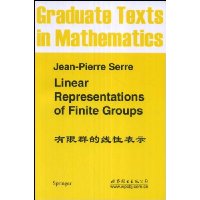| 商家名称 |
信用等级 |
购买信息 |
订购本书 |
|
|
 |
有限群的线性表示 |
 |
|
 |
有限群的线性表示 |
 |

基本信息·出版社:世界图书出版公司
·页码:170 页
·出版日期:2008年10月
·ISBN:7506292599/9787506292597
·条形码:9787506292597
·版本:第1版
·装帧:平装
·开本:24
·正文语种:英语
·外文书名:Linear Representations of Finite Groups
内容简介 《有限群的线性表示》是一部非常经典的介绍有限群线性表示的教程,原版曾多次修订重印,作者是当今法国最突出的数学家之一,他对理论数学有全面的了解,尤以著述清晰、明了闻名。《有限群的线性表示》是他写的为数不多的教科书之一,原文是法文(1971年版),后出了德译本和英译本。《有限群的线性表示》是英译本的重印本。它篇幅不大,但深入浅出的介绍了有限群的线性表示,并给出了在量子化学等方面的应用,便于广大数学、物理、化学工作者初学时阅读和参考。
目录 Part I
Representations and Characters
1 Generalities on linear representations
1.1 Definitions
1.2 Basic examples
1.3 Submpmsentations
1.4 Irreducible representations
1.5 Tensor product of two representations
1.6 Symmetric square and alternating square
2 Character theory
2.1 The character of a representation
2.2 Schur's lemma; basic applications
2.30rthogonality relations for characters
2.4 Decomposition of the regular representation
2.5 Number of irreducible representations
2.6 Canonical decomposition of a representation
2.7 Explicit decomposition of a representation
3 Subgroups, products, induced representations
3.1 Abelian subgroups
3.2 Product of two groups
3.3 Induced representations
4 Compact groups
4.1 Compact groups
4.2 lnvariant measure on a compact group
4.3 Linear representations of compact groups
5 Examples
5.1 The cyclic Group
5.2 The group
5.3 The dihedral group
5.4 The group
5.5 The group
5.6 The group
5.7 The alternating group
5.8 The symmetric group
5.9 The group of the cube
Bibliography: Part I
Part II
Representations in Characteristic Zero
6 The group algebra
6.1 Representations and modules
6.2 Decomposition of C[G]
6.3 The center of C[G]
6.4 Basic properties of integers
6.5 lntegrality properties of characters. Applications
7 Induced representations; Mackey's criterion
7.1 Induction
7.2 The character of an induced representation;
the reciprocity formula
7.3 Restriction to subgroups
7.4 Mackey's irreducibility criterion
8 Examples of induced representations
8. l Normal subgroups; applications to the degrees of the
in'educible representations
8.2 Semidirect products by an ahelian group
8.3 A review of some classes of finite groups
8.4 Syiow's theorem
8.5 Linear representations of superselvable groups
9 Artin's theorem
9.1 The ring R(G)
9.2 Statement of Artin's theorem
9.3 First proof
9.4 Second proof of (i) = (ii)
l0 A theorem of Brauer
10.1 p-regular elements;p-elementary subgroups
10.2 Induced characters arising from p-elementary
subgroups
10.3 Construction of characters
10.4 Proof of theorems 18 and 18'
10.5 Brauer's theorem
11 Applications of Brauer's theorem
I !. 1 Characterization of characters
11.2 A theorem of Frobenius
I 1.3 A converse to Brauer's theorem
11.4 The spectrum of A R(G)
12 Rationality questions
12.1 The rings RK(G) and RK(G)
12.2 Schur indices
i 2.3 Realizability over cyclotomic fields
12.4 The rank of RK(G)
12.5 Generalization of Artin's theorem
12.6 Generalization of Brauer's theorem
12.7 Proof of theorem 28
13 Rationality questions: examples
13. I The field Q
13.2 The field R
Bibliography: Part II
Part III
Introduction to Brauer Theory
14 The groups RK(G), R(G), and Pk(G)
14.1 The rings RK(G) and R,(G)
14.2 The groups Pk(G) and P^(G)
14.3 Structure of Pk(G)
14.4 Structure of PA(G)
14.5 Dualities
14.6 Scalar extensions
15 The cde triangle
15.1 Definition of c: Pk(G) --Rk(G)
15.2 Definition of d: Rs(G) -- Rk(G)
15.3 Definition of e: Pk(G) -- RK(G)
15.4 Basic properties of the cde triangle
15.5 Example: p'-gmups
15.6 Example: p-groups
15.7 Example: products ofp'-groups and p-groups
16 Theorems
16.1 Properties of the cde triangle
16.2 Characterization of the image of e
16.3 Characterization of projective A [G ]-modules
by their characters
16.4 Examples of projective A [G ]-modules: irreducible
representations of defect zero
17 Proofs
17. I Change of groups
17.2 Brauer's theorem in the modular case
17.3 Proof of theorem 33
17.4 Proof of theorem 35
17.5 Proof of theorem 37
17.6 Proof of theorem 38
18 Modular characters
! 8. ! The modular character of a representation
18.2 Independence of modular characters
18.3 Reformulations
18.4 A section ford
18.5 Example: Modular characters of the symmetric group
18.6 Example: Modular characters of the alternating group
19 Application to Artin representations
19.1 Artin and Swan representations
19.2 Rationality of the Artin and Swan representations
19.3 An invariant
Appendix
Bibliography: Part III
Index of notation
Index of terminology
……
序言 This book consists of three parts, rather different in level and purpose:
The first part was originally written for quantum chemists. It describes the correspondence, due to Frobenius, between linear representations and characters. This is a fundamental result, of constant use in mathematics as well as in quantum chemistry or physics. I have tried to give proofs as elementary as possible, using only the definition of a group and the rudiments of linear algebra.The examples (Chapter 5) have been chosen from those useful to chemists.
文摘 插图:






